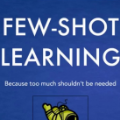We propose a novel method for solving regression tasks using few-shot or weak supervision. At the core of our method is the fundamental observation that GANs are incredibly successful at encoding semantic information within their latent space, even in a completely unsupervised setting. For modern generative frameworks, this semantic encoding manifests as smooth, linear directions which affect image attributes in a disentangled manner. These directions have been widely used in GAN-based image editing. We show that such directions are not only linear, but that the magnitude of change induced on the respective attribute is approximately linear with respect to the distance traveled along them. By leveraging this observation, our method turns a pre-trained GAN into a regression model, using as few as two labeled samples. This enables solving regression tasks on datasets and attributes which are difficult to produce quality supervision for. Additionally, we show that the same latent-distances can be used to sort collections of images by the strength of given attributes, even in the absence of explicit supervision. Extensive experimental evaluations demonstrate that our method can be applied across a wide range of domains, leverage multiple latent direction discovery frameworks, and achieve state-of-the-art results in few-shot and low-supervision settings, even when compared to methods designed to tackle a single task.
翻译:我们提出一种新颖的方法,用微小的或薄弱的监督方法解决回归任务。 我们的方法核心是基本观察,即GAN在潜在空间内,甚至在完全无人监督的环境下,在编码语义信息方面非常成功。 对于现代基因框架来说,这种语义编码显示为光滑的线性方向,以分解的方式影响图像属性。这些方向在基于GAN的图像编辑中被广泛使用。我们显示,这些方向不仅线性,而且各自属性的变化程度相对于它们之间距离而言大致是线性的。通过利用这一观察,我们的方法将预先训练的GAN转化为回归模型,以少数标注的样本为对象。这样可以解决数据集和属性上的回归任务,而这些数据和属性很难产生质量监督。此外,我们表明,即使没有明确的监督,也可以使用同样的潜在距离来根据给定属性的强度对图像进行分类。 广泛的实验性评估表明,我们的方法可以适用于几个广泛的领域,利用多种潜在方向的发现框架,甚至可以用来在比较的单个任务设置时,实现一个州式的视野。





